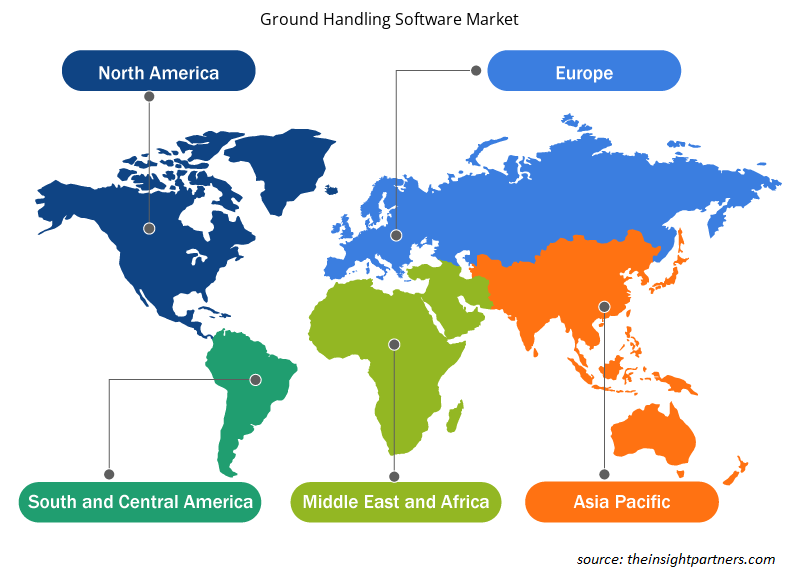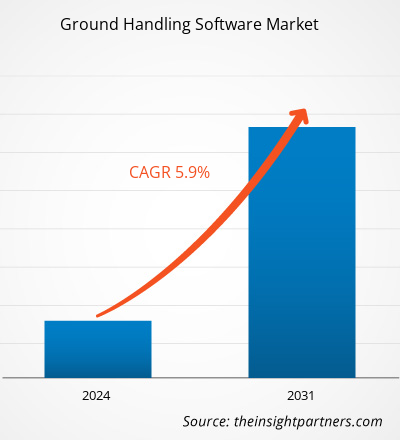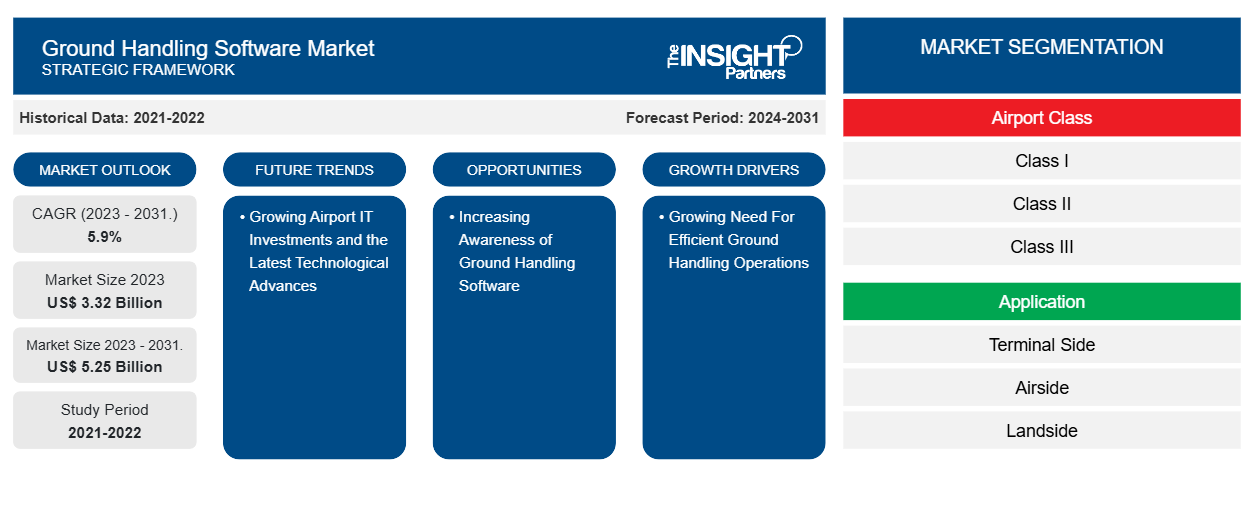Se prevé que el tamaño del mercado de software de asistencia en tierra alcance los 5.250 millones de dólares en 2031, frente a los 3.320 millones de dólares en 2023. Se espera que el mercado registre una CAGR del 5,9 % durante el período 2023-2031. Es probable que las crecientes inversiones en TI en los aeropuertos y los últimos avances tecnológicos sigan siendo una tendencia clave en el mercado.
Análisis del mercado de software de asistencia en tierra
La demanda de software de asistencia en tierra aumenta continuamente debido a los avances tecnológicos y al deseo de lograr operaciones aeroportuarias eficientes. La implementación de sistemas digitales que incluyen automatización, análisis de datos y computación en la nube para optimizar los procedimientos de asistencia en tierra está en aumento. Además, el impulso hacia la inyección de nuevas tecnologías y sistemas operativos en la industria está siendo impulsado por un entorno regulatorio de seguridad estricto y una mayor interacción de pasajeros por cuenta propia.
Descripción general del mercado de software de asistencia en tierra
El software de asistencia en tierra es un sistema que permite que todos los servicios que se llevan a cabo en el avión se presten en tierra de forma rápida y óptima. Entre ellos se incluyen aspectos como el abastecimiento de combustible, la restauración, la manipulación de equipajes y el mantenimiento de la aeronave. El software de asistencia en tierra es la medida definitiva que ha proporcionado a los proveedores de servicios combustible adicional y velocidad de crucero adicional, que son cruciales para reducir el tiempo de escala de los aviones y, por lo tanto, aumentar los ingresos.
Personalice este informe según sus necesidades
Obtendrá personalización en cualquier informe, sin cargo, incluidas partes de este informe o análisis a nivel de país, paquete de datos de Excel, así como también grandes ofertas y descuentos para empresas emergentes y universidades.
-
Obtenga las principales tendencias clave del mercado de este informe.Esta muestra GRATUITA incluirá análisis de datos, desde tendencias del mercado hasta estimaciones y pronósticos.
Factores impulsores y oportunidades del mercado del software de asistencia en tierra
Creciente necesidad de operaciones de asistencia en tierra eficientes
La creciente demanda de un manejo eficiente de las operaciones terrestres en los aeropuertos está impulsada por la necesidad de reducir los costos operativos y mejorar la satisfacción del cliente. En un contexto en el que los aeropuertos experimentan un aumento alarmante de la congestión, las aerolíneas están buscando formas de acortar los tiempos de respuesta, mejorar la precisión de las operaciones de manejo y reducir los retrasos. El software de manejo en tierra es la solución que permite a las aerolíneas manejar las actividades en tierra con facilidad, reduciendo así los costos operativos y mejorando la experiencia del cliente. La tecnología facilita los procedimientos involucrados en el manejo y ayuda a una aerolínea a prepararse con anticipación para la adversidad del creciente tráfico aéreo en un entorno operativo altamente efectivo y orientado al cliente.
Aumentar la conciencia sobre el software de asistencia en tierra
Cada vez hay más conciencia de los beneficios que puede aportar el software de asistencia en tierra a la adopción de la automatización y la tecnología en las operaciones de asistencia en tierra. Al comprender la competitividad de una industria, las aerolíneas buscan formas de mejorar la productividad operativa y, al mismo tiempo, reducir los costos siendo sensibles al precio. El software de asistencia en tierra proporciona a las aerolíneas los medios para automatizar la mayoría de sus operaciones de asistencia en tierra; esto, por lo tanto, reduce los costos generales y mejora la eficiencia operativa. La creciente conciencia de estos beneficios en realidad impulsa la tasa de adopción de software de asistencia en tierra en los aeropuertos.
Análisis de segmentación del informe de mercado de software de asistencia en tierra
Los segmentos clave que contribuyeron a la derivación del análisis del mercado de software de asistencia en tierra son la clase de aeropuerto, la aplicación y el tipo de software.
- Según la clase de aeropuerto, el mercado se segmenta en Clase I, Clase II, Clase III y Clase IV. El segmento de Clase I tuvo una participación de mercado significativa en 2023.
- En términos de aplicación, el mercado está segmentado en el lado terminal, el lado aire y el lado tierra. El segmento del lado terminal tuvo una participación de mercado significativa en 2023.airside, and landside. The terminal side segment held a significant market share in 2023.
- Según el tipo de software, el mercado se segmenta en control de embarque y salida de pasajeros, gestión de equipaje, control automatizado de carga y descarga, seguimiento de GSE (telemetría) y gestión de rampas. El segmento de gestión de equipaje tuvo una participación de mercado significativa en 2023.GSE tracking (telemetry), and ramp management. The baggage management segment held a significant market share in 2023.
Análisis de la cuota de mercado del software de asistencia en tierra por geografía
El alcance geográfico del informe de mercado de software de asistencia en tierra se divide principalmente en cinco regiones: América del Norte, Asia Pacífico, Europa, Medio Oriente y África, y América del Sur y Central.
El mercado norteamericano de software de asistencia en tierra está creciendo abruptamente debido a la creciente demanda de soluciones de asistencia en tierra eficientes y rentables por parte de varias aerolíneas y aeropuertos. Esta región alberga la mayoría de las aerolíneas y aeropuertos más grandes del mundo, que están invirtiendo fuertemente en software de asistencia en tierra para lograr mejoras en la eficiencia operativa y la reducción de costos. Los proveedores de software de asistencia en tierra en la región han aumentado, lo que motiva la competencia y la innovación. En general, el crecimiento del mercado norteamericano de software de asistencia en tierra es fuerte, impulsado por la creciente demanda de las aerolíneas y los aeropuertos de soluciones de asistencia en tierra eficientes y rentables, el aumento de los proveedores de software de asistencia en tierra y la adopción de soluciones basadas en la nube.
Perspectivas regionales del mercado de software de asistencia en tierra
Los analistas de Insight Partners explicaron en detalle las tendencias y los factores regionales que influyen en el mercado de software de asistencia en tierra durante el período de pronóstico. Esta sección también analiza los segmentos y la geografía del mercado de software de asistencia en tierra en América del Norte, Europa, Asia Pacífico, Oriente Medio y África, y América del Sur y Central.

- Obtenga datos regionales específicos para el mercado de software de asistencia en tierra
Alcance del informe de mercado de software de asistencia en tierra
| Atributo del informe | Detalles |
|---|---|
| Tamaño del mercado en 2023 | US$ 3.32 mil millones |
| Tamaño del mercado en 2031 | 5.250 millones de dólares estadounidenses |
| CAGR global (2023 - 2031). | 5,9% |
| Datos históricos | 2021-2022 |
| Período de pronóstico | 2024-2031 |
| Segmentos cubiertos |
Por clase de aeropuerto
|
| Regiones y países cubiertos |
América del norte
|
| Líderes del mercado y perfiles de empresas clave |
|
Densidad de actores del mercado de software de asistencia en tierra: comprensión de su impacto en la dinámica empresarial
El mercado de software de asistencia en tierra está creciendo rápidamente, impulsado por la creciente demanda de los usuarios finales debido a factores como la evolución de las preferencias de los consumidores, los avances tecnológicos y una mayor conciencia de los beneficios del producto. A medida que aumenta la demanda, las empresas amplían sus ofertas, innovan para satisfacer las necesidades de los consumidores y aprovechan las tendencias emergentes, lo que impulsa aún más el crecimiento del mercado.
La densidad de actores del mercado se refiere a la distribución de las empresas o firmas que operan dentro de un mercado o industria en particular. Indica cuántos competidores (actores del mercado) están presentes en un espacio de mercado determinado en relación con su tamaño o valor total de mercado.
Las principales empresas que operan en el mercado de software de asistencia en tierra son:
- Soluciones Arepo Ltda.
- Avtura limitada
- Sistemas Damarel Internacional Ltd.
- INFORM GmbH
- Soluciones de aviación cuántica
- Quonext
Descargo de responsabilidad : Las empresas enumeradas anteriormente no están clasificadas en ningún orden particular.

- Obtenga una descripción general de los principales actores clave del mercado de software de asistencia en tierra
Noticias y desarrollos recientes del mercado de software de asistencia en tierra
El mercado de software de asistencia en tierra se evalúa mediante la recopilación de datos cualitativos y cuantitativos a partir de una investigación primaria y secundaria, que incluye publicaciones corporativas importantes, datos de asociaciones y bases de datos. A continuación, se enumeran algunos de los avances en el mercado de software de asistencia en tierra:
- Menzies Aviation, el socio de servicios líder para aeropuertos y aerolíneas del mundo, junto con la empresa líder en servicios tecnológicos y consultoría Wipro, ha anunciado el exitoso lanzamiento de su nuevo sistema de gestión de carga Menzies Aviation Cargo Handling (MACH).
(Fuente: Menzies Aviation Limited, sitio web de la empresa, diciembre de 2023)
Informe sobre el mercado de software de asistencia en tierra: cobertura y resultados
El informe “Tamaño y pronóstico del mercado de software de asistencia en tierra (2021-2031)” proporciona un análisis detallado del mercado que cubre las siguientes áreas:
- Tamaño del mercado de software de asistencia en tierra y pronóstico a nivel mundial, regional y nacional para todos los segmentos clave del mercado cubiertos bajo el alcance
- Tendencias del mercado de software de asistencia en tierra, así como dinámicas del mercado, como impulsores, restricciones y oportunidades clave
- Análisis detallado de las cinco fuerzas de Porter y PEST y FODA
- Análisis del mercado de software de asistencia en tierra que abarca las tendencias clave del mercado, el marco global y regional, los principales actores, las regulaciones y los desarrollos recientes del mercado
- Análisis del panorama de la industria y de la competencia que abarca la concentración del mercado, el análisis de mapas de calor, los actores destacados y los desarrollos recientes del mercado de software de asistencia en tierra
- Perfiles detallados de empresas
- Análisis histórico (2 años), año base, pronóstico (7 años) con CAGR
- Análisis PEST y FODA
- Tamaño del mercado, valor/volumen: global, regional y nacional
- Industria y panorama competitivo
- Conjunto de datos de Excel
Informes recientes
Informes relacionados
Testimonios
Razón para comprar
- Toma de decisiones informada
- Comprensión de la dinámica del mercado
- Análisis competitivo
- Información sobre clientes
- Pronósticos del mercado
- Mitigación de riesgos
- Planificación estratégica
- Justificación de la inversión
- Identificación de mercados emergentes
- Mejora de las estrategias de marketing
- Impulso de la eficiencia operativa
- Alineación con las tendencias regulatorias























 Obtenga una muestra gratuita para - Mercado de software de asistencia en tierra
Obtenga una muestra gratuita para - Mercado de software de asistencia en tierra